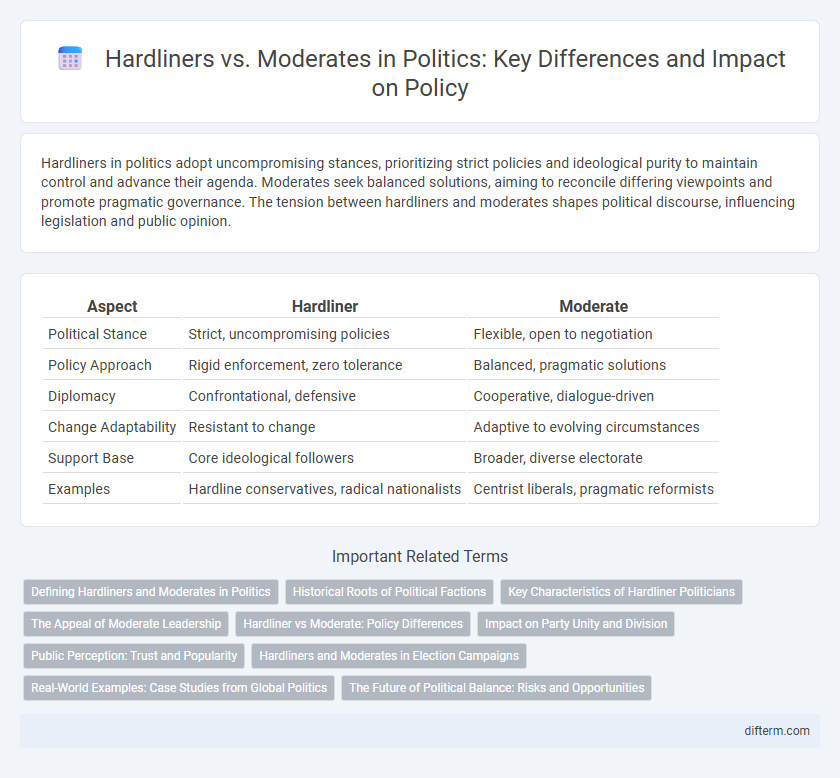Hardliners in politics adopt uncompromising stances, prioritizing strict policies and ideological purity to maintain control and advance their agenda. Moderates seek balanced solutions, aiming to reconcile differing viewpoints and promote pragmatic governance. The tension between hardliners and moderates shapes political discourse, influencing legislation and public opinion.
Table of Comparison
| Aspect | Hardliner | Moderate |
|---|---|---|
| Political Stance | Strict, uncompromising policies | Flexible, open to negotiation |
| Policy Approach | Rigid enforcement, zero tolerance | Balanced, pragmatic solutions |
| Diplomacy | Confrontational, defensive | Cooperative, dialogue-driven |
| Change Adaptability | Resistant to change | Adaptive to evolving circumstances |
| Support Base | Core ideological followers | Broader, diverse electorate |
| Examples | Hardline conservatives, radical nationalists | Centrist liberals, pragmatic reformists |
Defining Hardliners and Moderates in Politics
Hardliners in politics advocate for strict, uncompromising policies and often resist negotiation or concessions, emphasizing ideological purity and national security. Moderates prioritize pragmatic solutions, seeking common ground and balancing diverse interests to achieve incremental progress. The distinction between hardliners and moderates significantly shapes legislative agendas, party dynamics, and diplomatic strategies.
Historical Roots of Political Factions
Hardliners and moderates trace their origins to divergent responses during key historical conflicts, such as the French Revolution's Jacobins versus Girondins or the U.S. Federalists against Anti-Federalists debates. These factions embody contrasting approaches to governance, with hardliners advocating strict adherence to ideology and moderates seeking pragmatic compromise. The evolution of these political spectrums reveals enduring tensions between radical reform and cautious progress in shaping policy and party identity.
Key Characteristics of Hardliner Politicians
Hardliner politicians exhibit unwavering commitment to strict ideological principles, often prioritizing security and national sovereignty over diplomatic flexibility. They tend to reject compromise, favoring aggressive policies and enforcement measures to achieve their goals. Their leadership style is marked by rigidity, resistance to reform, and a preference for authoritative decision-making.
The Appeal of Moderate Leadership
Moderate leadership appeals to a broader electorate by promoting pragmatic solutions and fostering bipartisan cooperation, which can lead to more stable governance and effective policy implementation. Voters often prefer moderates for their ability to balance competing interests and reduce political polarization, creating an environment conducive to compromise. In contrast to hardliners, moderates emphasize inclusivity and incremental progress, appealing to those seeking practical results over ideological rigidity.
Hardliner vs Moderate: Policy Differences
Hardliners advocate for stringent policies, emphasizing strict enforcement of laws, national security, and often favoring protectionist economic measures. Moderates support balanced approaches, promoting compromise, incremental reforms, and policies that aim to accommodate diverse viewpoints within society. The policy differences between hardliners and moderates significantly impact legislative priorities and governance strategies.
Impact on Party Unity and Division
Hardliners often intensify party divisions by advocating uncompromising policies, which can alienate moderate members and fracture internal consensus. Moderates seek to bridge ideological gaps, promoting compromise that fosters party cohesion but may frustrate hardliners seeking ideological purity. The tension between these factions significantly influences party unity, with shifts in dominance affecting electoral strategies and legislative effectiveness.
Public Perception: Trust and Popularity
Hardliners often face lower public trust due to perceived rigidity and unwillingness to compromise, while moderates typically enjoy higher popularity by appealing to a broader electorate through balanced policies. Public perception of hardliners as uncompromising can alienate centrist voters, diminishing their overall political capital. Moderates leverage this trust advantage to build coalitions and maintain sustained support in diverse political landscapes.
Hardliners and Moderates in Election Campaigns
Hardliners often emphasize strict ideological positions and aggressive policy stances to energize their core base, framing elections as existential battles that demand unwavering loyalty. Moderates adopt more pragmatic messaging, appealing to a broader electorate by promoting compromise, stability, and incremental reforms. Election campaigns driven by hardliners tend to polarize voters, while moderates seek to build coalitions across diverse political groups.
Real-World Examples: Case Studies from Global Politics
Hardliner approaches often shape policies in countries like North Korea, where rigid stances enforce strict control and limited diplomatic engagement, contrasting sharply with moderate strategies exemplified by Germany's coalition governments that emphasize negotiation and compromise. In the Middle East, Israel's political spectrum reveals hardliner factions pushing for security-first policies, while moderates advocate for peace talks and regional cooperation. These real-world dynamics highlight how hardliner and moderate ideologies influence conflict resolution and international relations across diverse geopolitical landscapes.
The Future of Political Balance: Risks and Opportunities
Hardliners often prioritize ideological rigidity and strict policy enforcement, creating risks of political polarization and legislative gridlock. Moderates drive compromise and pragmatic governance, offering opportunities for bipartisan collaboration and more stable policy outcomes. The future of political balance hinges on managing tensions between these factions to foster effective decision-making and social cohesion.
hardliner vs moderate Infographic

 difterm.com
difterm.com